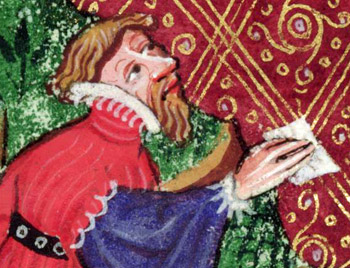King Alisaunder
General Information
Plot Summary

The astrologer Neptabanus seduces Olympias, wife of King Philip of Macedon, by disguising himself as the god Jupiter Ammon. She bears a son named Alexander who, aged twelve, kills Neptabanus and tames the wild horse Buciphal, for which he is named as Philip’s heir. As a young man, Alexander enforces Philip’s interests abroad, defeating his enemies and refusing to pay tribute to Darius of Persia. When Olympias and her lover murder Philip, Alexander briefly returns to claim his crown, before continuing his military campaign across Europe and North Africa. As he passes through Tripoli, an idol informs him that Philip was his real father.
Alexander lays siege to Tyre, losing many men. Darius continues to demand tribute and Alexander, still refusing, marches towards Arabia to confront him, sacking cities on his way. The two armies fight violently until Darius flees to Babylon, abandoning his men and his female relatives, whom Alexander looks after. Hearing that Darius is marshalling an even greater army, Alexander summons troops from his conquered territories and marches onwards. He sacks the city of Thebes, Athens reluctantly agrees to pay him tribute, and Macedoyne is surrendered to him by its female inhabitants. At length he reaches Darius’ troops, who are assembled on one bank of the Tigris, and sets up camp on the other. Alexander fails to swim across the river, and is rescued by his men.
Some of Alexander’s men cross the Tigris without his knowledge and ambush a section of Darius’ army. They kill many, but are driven back by Persian reinforcements. Alexander and the rest of his men intervene, and the battle begins in earnest. Darius promises his daughter to anyone who overcomes Alexander, but a Persian knight disguised in Greek armour fails to kill him.
Alexander tricks Darius into shifting his troops, then moves his own men across the river. He enters Darius’ camp disguised as a messenger, but is recognised and escapes, hotly pursued. At length, the Greek troops ambush the Persians after pretending to flee. In the ensuing battle, many men are slain and Darius retreats to Babylon. When Alexander does not reply to his request for peace, he sends to Porus, King of India, for help. Attempting to steal out of the city, however, he is mortally wounded by two traitors. Alexander discovers him and mourns his death, before arranging his funeral and hanging the traitors.
Alexander travels to India in pursuit of Porus, and the poet describes the cities and peoples of the continent. As they cross the desert, Alexander’s men suffer greatly from thirst, and their search for water leads them into confrontations with terrifying beasts. Finally they reach Baudus, Porus’ city. Alexander enters in disguise and tricks Porus into issuing a challenge: his army defeated, Porus agrees to accompany Alexander on his campaign throughout India. They travel widely, slaying those who resist them and observing many marvellous peoples and beasts.
Having subdued India, Alexander resolves to crush the wicked people of Gog, Magog and Taracun. His men initially struggle against the underhand tactics of these hideous peoples, but after seeking the advice of an oracle, Alexander uses bitumen (obtained from the sea-dwelling Meopantes) to seal them into their land. He then proceeds to Africa and travels through Ethiopia and Egypt, observing their strange peoples and beasts. He returns to India, passing through the lands of Queen Candace, who declares her love via letter: Alexander rides on, but the queen’s metal smith creates an image of him.
After visiting the trees of the Sun and the Moon, which prophecy his death the following year, Alexander continues through the Caspian Gates, where great numbers of his men are killed by ferocious beasts. He seeks shelter and sends for reinforcements, in the meantime founding a noble city named after himself. Porus, learning of Alexander’s weakened state, plans to overthrow him, but when Alexander challenges him to single combat for control of India, is defeated and slain. Alexander consolidates his rule until Candulek, son of Queen Candace, appeals to him for help. Dressing one of his nobles as a king, Alexander defeats Candulek’s enemy in the guise of a lord and travels to Candace’s court. The Queen recognises him from his image, however, and induces him to become her lover: he remains with her until he is discovered by her second son, an ally of Porus.
Alexander returns to Babylon and begins preparations for a campaign in Africa. Before he can set out, however, he drinks wine poisoned by a recently deposed justice and dies. His men mourn his death, divide his lands, and bury him in the city that he founded.
From: Kyng Alisaunder, ed. G.V. Smithers, London, Early English Text Society os 227 and 237, London, 1952.
Manuscript: Oxford, Bodleian Library, MS Laud Misc 622.
Manuscripts
Click a title below to search for all romances in that manuscript.